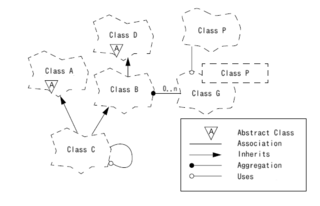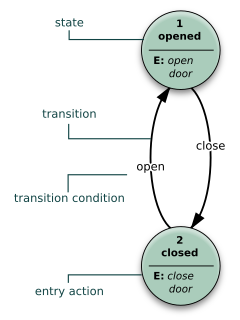
The Booch method is a method for object-oriented software development. It is composed of an object modeling language, an iterative object-oriented development process, and a set of recommended practices.

The Unified Modeling Language (UML) is a general-purpose, developmental, modeling language in the field of software engineering that is intended to provide a standard way to visualize the design of a system.
The Rational Unified Process (RUP) is an iterative software development process framework created by the Rational Software Corporation, a division of IBM since 2003. RUP is not a single concrete prescriptive process, but rather an adaptable process framework, intended to be tailored by the development organizations and software project teams that will select the elements of the process that are appropriate for their needs. RUP is a specific implementation of the Unified Process.
Rational Machines was founded by Paul Levy and Mike Devlin in 1981 to provide tools to expand the use of modern software engineering practices, particularly explicit modular architecture and iterative development. It changed its name in 1994 to Rational Software, and was sold for US$2.1 billion to IBM on February 20, 2003.
Model-driven architecture (MDA) is a software design approach for the development of software systems. It provides a set of guidelines for the structuring of specifications, which are expressed as models. Model-driven architecture is a kind of domain engineering, and supports model-driven engineering of software systems. It was launched by the Object Management Group (OMG) in 2001.
The Object Constraint Language (OCL) is a declarative language describing rules applying to Unified Modeling Language (UML) models developed at IBM and is now part of the UML standard. Initially, OCL was merely a formal specification language extension for UML. OCL may now be used with any Meta-Object Facility (MOF) Object Management Group (OMG) meta-model, including UML. The Object Constraint Language is a precise text language that provides constraint and object query expressions on any MOF model or meta-model that cannot otherwise be expressed by diagrammatic notation. OCL is a key component of the new OMG standard recommendation for transforming models, the Queries/Views/Transformations (QVT) specification.

Grady Booch is an American software engineer, best known for developing the Unified Modeling Language (UML) with Ivar Jacobson and James Rumbaugh. He is recognized internationally for his innovative work in software architecture, software engineering, and collaborative development environments.

Computer-aided software engineering (CASE) is the domain of software tools used to design and implement applications. CASE tools are similar to and were partly inspired by computer-aided design (CAD) tools used for designing hardware products. CASE tools are used for developing high-quality, defect-free, and maintainable software. CASE software is often associated with methods for the development of information systems together with automated tools that can be used in the software development process.
James E. Rumbaugh is an American computer scientist and object-oriented methodologist who is best known for his work in creating the Object Modeling Technique (OMT) and the Unified Modeling Language (UML).

Ivar Hjalmar Jacobson is a Swedish-American computer scientist and software engineer, known as major contributor to UML, Objectory, Rational Unified Process (RUP), aspect-oriented software development and Essence.

A metamodel or surrogate model is a model of a model, and metamodeling is the process of generating such metamodels. Thus metamodeling or meta-modeling is the analysis, construction and development of the frames, rules, constraints, models and theories applicable and useful for modeling a predefined class of problems. As its name implies, this concept applies the notions of meta- and modeling in software engineering and systems engineering. Metamodels are of many types and have diverse applications.

An information model in software engineering is a representation of concepts and the relationships, constraints, rules, and operations to specify data semantics for a chosen domain of discourse. Typically it specifies relations between kinds of things, but may also include relations with individual things. It can provide sharable, stable, and organized structure of information requirements or knowledge for the domain context.
The Shlaer–Mellor method, also known as Object-Oriented Systems Analysis (OOSA) or Object-Oriented Analysis (OOA) is an object-oriented software development methodology introduced by Sally Shlaer and Stephen Mellor in 1988. The method makes the documented analysis so precise that it is possible to implement the analysis model directly by translation to the target architecture, rather than by elaborating model changes through a series of more platform-specific models. In the new millennium the Shlaer–Mellor method has migrated to the UML notation, becoming Executable UML.
Object-oriented analysis and design (OOAD) is a technical approach for analyzing and designing an application, system, or business by applying object-oriented programming, as well as using visual modeling throughout the software development process to guide stakeholder communication and product quality.

Activity diagrams are graphical representations of workflows of stepwise activities and actions with support for choice, iteration and concurrency. In the Unified Modeling Language, activity diagrams are intended to model both computational and organizational processes, as well as the data flows intersecting with the related activities. Although activity diagrams primarily show the overall flow of control, they can also include elements showing the flow of data between activities through one or more data stores.
UML Partners was a consortium of system integrators and vendors convened in 1996 to specify the Unified Modeling Language (UML). Initially the consortium was led by Grady Booch, Ivar Jacobson, and James Rumbaugh of Rational Software. The UML Partners' UML 1.0 specification draft was proposed to the Object Management Group (OMG) in January 1997. During the same month the UML Partners formed a Semantics Task Force, chaired by Cris Kobryn, to finalize the semantics of the specification and integrate it with other standardization efforts. The result of this work, UML 1.1, was submitted to the OMG in August 1997 and adopted by the OMG in November 1997.
Model-driven engineering (MDE) is a software development methodology that focuses on creating and exploiting domain models, which are conceptual models of all the topics related to a specific problem. Hence, it highlights and aims at abstract representations of the knowledge and activities that govern a particular application domain, rather than the computing concepts.

Metadata modeling is a type of metamodeling used in software engineering and systems engineering for the analysis and construction of models applicable to and useful for some predefined class of problems.
Information technology architecture is the process of development of methodical information technology specifications, models and guidelines, using a variety of Information Technology notations, for example UML, within a coherent Information Technology architecture framework, following formal and informal Information Technology solution, enterprise, and infrastructure architecture processes. These processes have been developed in the past few decades in response to the requirement for a coherent, consistent approach to delivery of information technology capabilities. They have been developed by information technology product vendors and independent consultancies, based on real experiences in the information technology marketplace and collaboration amongst industry stakeholders, for example the Open Group. Best practice Information Technology architecture encourages the use of open technology standards and global technology interoperability. Information Technology (I.T) Architecture can also be called a high-level map or plan of the information assets in an organization, including the physical design of the building that holds the hardware.

UML is a modeling language used by software developers. UML can be used to develop diagrams and provide users (programmers) with ready-to-use, expressive modeling examples. Some UML tools generate program language code from UML. UML can be used for modeling a system independent of a platform language. UML is a graphical language for visualizing, specifying, constructing, and documenting information about software-intensive systems. UML gives a standard way to write a system model, covering conceptual ideas. With an understanding of modeling, the use and application of UML can make the software development process more efficient.











